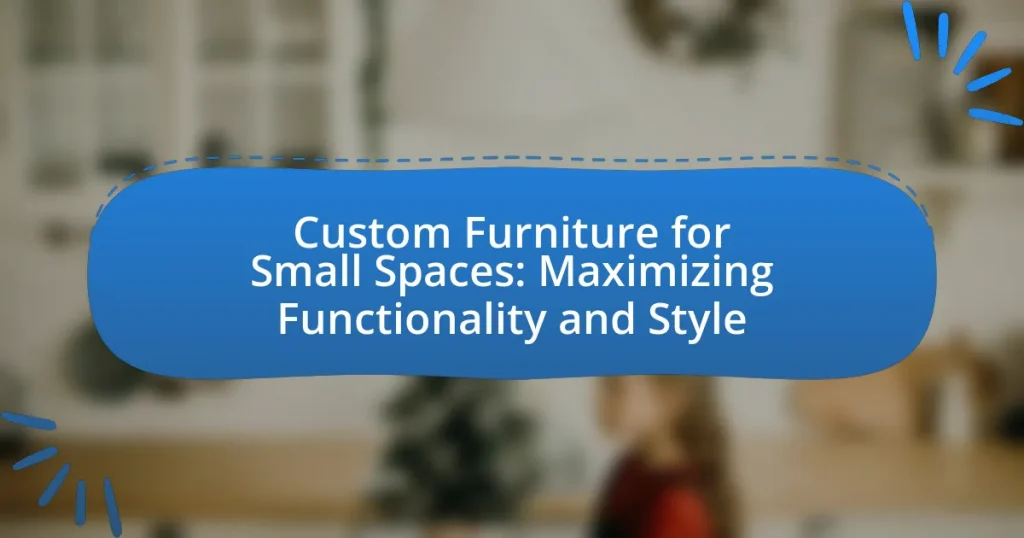Custom furniture for small spaces is specifically designed to enhance functionality and efficiency in limited areas, allowing for optimal use of space while maintaining aesthetic appeal. This article explores the differences between custom and standard furniture, highlighting the advantages of tailored solutions that maximize storage and usability. Key features of custom furniture include multi-functionality, space-saving designs, and the ability to fit specific dimensions, all of which contribute to a cohesive aesthetic. Additionally, the article discusses considerations for designing custom pieces, the importance of material selection, and practical tips for incorporating furniture into compact environments effectively.

What is Custom Furniture for Small Spaces?
Custom furniture for small spaces refers to specially designed furniture that maximizes functionality and efficiency in limited areas. This type of furniture is tailored to fit specific dimensions and needs, allowing for optimal use of space while maintaining aesthetic appeal. For example, modular sofas, foldable tables, and built-in storage solutions are common types of custom furniture that cater to small living environments, ensuring that every square foot is utilized effectively.
How does custom furniture differ from standard furniture?
Custom furniture is specifically designed to meet individual needs and preferences, while standard furniture is mass-produced with fixed dimensions and styles. Custom furniture allows for tailored dimensions, materials, and aesthetics that fit unique spaces and personal tastes, enhancing functionality and style in small areas. In contrast, standard furniture often lacks the flexibility to adapt to specific spatial constraints or design requirements, making it less suitable for maximizing utility in compact environments.
What are the key features of custom furniture for small spaces?
Custom furniture for small spaces is designed to maximize functionality and optimize available space. Key features include multi-functionality, allowing pieces to serve more than one purpose, such as a sofa bed or an ottoman with storage. Additionally, custom furniture often incorporates space-saving designs, like foldable tables or modular units that can be rearranged as needed. Tailored dimensions ensure that each piece fits perfectly within the specific measurements of the room, enhancing usability without overcrowding. Furthermore, the use of vertical space through shelving or wall-mounted units is common, providing storage solutions without taking up floor area. These features collectively enable efficient use of limited space while maintaining aesthetic appeal.
Why is customization important for small living areas?
Customization is important for small living areas because it allows for the optimization of limited space to meet specific needs and preferences. In small living areas, standard furniture often fails to fit well or serve multiple functions, leading to inefficiency. Custom furniture can be designed to maximize storage, enhance functionality, and fit the unique dimensions of the space, ensuring that every square foot is utilized effectively. For instance, a study by the American Institute of Architects highlights that tailored solutions can increase usability in compact environments, making them more livable and aesthetically pleasing.
What are the advantages of using custom furniture in small spaces?
Custom furniture in small spaces offers tailored solutions that maximize functionality and optimize available space. By designing pieces specifically for the dimensions and layout of a room, custom furniture can enhance storage options, such as incorporating built-in shelves or multi-functional items like sofa beds. This approach not only improves the usability of the space but also allows for a cohesive aesthetic that reflects personal style. According to a study by the American Institute of Architects, 70% of homeowners reported increased satisfaction with their living areas after implementing custom solutions, highlighting the effectiveness of personalized design in enhancing small environments.
How does custom furniture maximize space efficiency?
Custom furniture maximizes space efficiency by being tailored to fit specific dimensions and functional needs of a space. This customization allows for optimal use of available square footage, ensuring that every inch is utilized effectively. For instance, built-in shelves can be designed to fit snugly into alcoves, while multi-functional pieces, such as a sofa bed, can serve dual purposes without occupying additional space. According to a study by the American Institute of Architects, custom solutions can increase usable space by up to 30% compared to standard furniture, demonstrating the tangible benefits of tailored designs in small areas.
In what ways can custom furniture enhance the aesthetic appeal of small areas?
Custom furniture enhances the aesthetic appeal of small areas by providing tailored designs that maximize space efficiency and visual harmony. Tailored dimensions ensure that each piece fits perfectly within the available area, avoiding clutter and creating a cohesive look. Additionally, custom furniture allows for the selection of materials, colors, and finishes that complement the existing decor, thereby enhancing the overall aesthetic. For instance, a study by the American Society of Interior Designers highlights that personalized furniture can significantly improve the perception of space and style in compact living environments.

What considerations should be made when designing custom furniture for small spaces?
When designing custom furniture for small spaces, prioritize multifunctionality to maximize utility. Furniture that serves multiple purposes, such as a sofa bed or an ottoman with storage, can significantly enhance the usability of limited areas. Additionally, consider the scale and proportion of the furniture; pieces should be appropriately sized to avoid overwhelming the space. According to a study by the American Institute of Architects, well-proportioned furniture can create an illusion of more space, making areas feel larger and more open. Lastly, opt for lightweight and modular designs that can be easily rearranged or moved, allowing for flexibility in layout and functionality.
How do you determine the right dimensions for custom furniture?
To determine the right dimensions for custom furniture, start by measuring the available space where the furniture will be placed. Accurate measurements of the room, including length, width, and height, are essential to ensure the furniture fits appropriately without overcrowding the area. Additionally, consider the scale of existing furniture and the intended use of the custom piece, as this will influence the dimensions needed for functionality and comfort. For example, a sofa should allow for adequate seating space while maintaining pathways for movement. According to the National Kitchen and Bath Association, optimal space planning often requires leaving at least 36 inches of clearance for walkways, which can guide dimension decisions for custom pieces.
What tools can help in measuring and planning for custom furniture?
Tools that can help in measuring and planning for custom furniture include digital measuring tapes, 3D modeling software, and design apps. Digital measuring tapes provide precise measurements and often feature Bluetooth connectivity to sync with mobile devices, enhancing accuracy in planning. 3D modeling software, such as SketchUp or AutoCAD, allows users to visualize furniture designs in a virtual space, facilitating better spatial planning. Design apps like RoomSketcher or MagicPlan enable users to create floor plans and experiment with furniture layouts, ensuring optimal use of small spaces. These tools collectively enhance the efficiency and effectiveness of custom furniture planning.
How can you ensure that custom furniture fits seamlessly into existing decor?
To ensure that custom furniture fits seamlessly into existing decor, it is essential to consider the color palette, materials, and design style of the current space. Matching the custom furniture’s colors with the existing decor creates visual harmony, while using similar materials, such as wood or metal finishes, enhances cohesion. Additionally, aligning the design style—whether modern, traditional, or eclectic—ensures that the new piece complements the overall aesthetic. Research indicates that cohesive design elements can significantly enhance the perceived value and comfort of a space, making it feel more inviting and well-planned.
What materials are best suited for custom furniture in small spaces?
Plywood and engineered wood are best suited for custom furniture in small spaces due to their lightweight nature and versatility. Plywood offers strength while being easy to cut and shape, allowing for creative designs that maximize limited space. Engineered wood, such as MDF or particleboard, provides a smooth surface for finishes and is often more affordable, making it ideal for budget-conscious projects. Additionally, materials like metal and glass can enhance the aesthetic appeal without adding bulk, as they create an illusion of openness. These materials are commonly used in small space furniture design because they balance functionality with style, ensuring that the furniture remains practical while fitting seamlessly into compact environments.
What are the benefits of using lightweight materials?
The benefits of using lightweight materials include enhanced mobility, ease of handling, and reduced structural load. Lightweight materials, such as aluminum and engineered wood, facilitate the design of versatile furniture that can be easily rearranged in small spaces. For instance, furniture made from lightweight materials can be moved without requiring significant effort, making it ideal for dynamic living environments. Additionally, using lightweight materials can lead to lower transportation costs and reduced energy consumption during manufacturing, as they require less energy to produce and transport compared to heavier alternatives. This efficiency contributes to sustainability in furniture design, aligning with modern consumer preferences for eco-friendly products.
How do different materials affect the durability and style of custom furniture?
Different materials significantly influence the durability and style of custom furniture. For instance, hardwoods like oak and maple offer high durability due to their dense structure, making them resistant to wear and tear, while also providing a classic aesthetic that enhances style. In contrast, softwoods such as pine are less durable but can be styled in a more rustic or casual manner, appealing to different design preferences.
Additionally, materials like metal and glass can contribute to a modern and sleek look, while also providing durability; metal frames are often resistant to bending and breaking, and glass surfaces are easy to clean and maintain. Upholstery materials, such as leather or high-performance fabrics, can enhance both comfort and style, with leather offering a luxurious appearance and durability against stains.
Research indicates that the choice of material directly correlates with the lifespan of furniture; for example, a study published in the Journal of Furniture Science found that furniture made from engineered wood products can offer comparable durability to solid wood while allowing for more intricate designs. Thus, selecting the right material is crucial for achieving the desired balance of durability and style in custom furniture.

How can you effectively incorporate custom furniture into small spaces?
To effectively incorporate custom furniture into small spaces, prioritize multifunctional designs that maximize utility without overwhelming the area. For instance, a custom sofa bed can serve as both seating and a sleeping area, while a coffee table with storage can reduce clutter. According to a study by the American Institute of Architects, 70% of homeowners in small spaces reported increased satisfaction with custom furniture that meets specific needs, demonstrating that tailored solutions enhance both functionality and aesthetic appeal.
What design styles work best with custom furniture in compact areas?
Minimalist and multifunctional design styles work best with custom furniture in compact areas. These styles prioritize simplicity and efficiency, allowing for tailored furniture solutions that maximize space without sacrificing aesthetics. For instance, minimalist design often incorporates clean lines and a neutral color palette, which can make small areas feel larger and more open. Additionally, multifunctional furniture, such as a sofa bed or a coffee table with storage, enhances usability in limited spaces, providing both comfort and practicality. Studies show that well-designed compact spaces can improve functionality by up to 30%, demonstrating the effectiveness of these design styles in optimizing small living environments.
How can you blend functionality and style in your custom furniture choices?
To blend functionality and style in custom furniture choices, prioritize designs that serve multiple purposes while reflecting personal aesthetics. For instance, selecting a coffee table with built-in storage not only enhances organization but also complements the room’s decor. Research indicates that multifunctional furniture can maximize space efficiency, particularly in small areas, making it a practical choice for homeowners. By integrating elements like sleek lines and contemporary materials, the furniture can maintain a stylish appearance while fulfilling essential roles in daily life.
What role does color play in making small spaces feel larger with custom furniture?
Color plays a crucial role in making small spaces feel larger when using custom furniture by influencing perception and creating visual continuity. Lighter colors, such as whites, pastels, and soft neutrals, reflect more light, which can enhance the sense of openness and airiness in a confined area. For instance, a study published in the Journal of Environmental Psychology indicates that lighter shades can make a room appear more spacious compared to darker hues, which tend to absorb light and create a more enclosed feeling. Additionally, using a monochromatic color scheme with custom furniture can eliminate visual clutter, further contributing to the perception of space.
What are some common mistakes to avoid when choosing custom furniture for small spaces?
Common mistakes to avoid when choosing custom furniture for small spaces include selecting oversized pieces, neglecting multifunctionality, and failing to measure dimensions accurately. Oversized furniture can overwhelm a small area, making it feel cramped and uncomfortable. Neglecting multifunctionality means missing out on furniture that can serve multiple purposes, such as a sofa bed or an ottoman with storage, which is essential for maximizing space. Additionally, failing to measure dimensions accurately can lead to purchasing items that do not fit well, resulting in wasted space and potential inconvenience. These mistakes can significantly hinder the effectiveness of furniture in small living areas.
How can over-furnishing impact the functionality of a small space?
Over-furnishing can significantly hinder the functionality of a small space by creating clutter and limiting movement. When too many pieces of furniture are crammed into a confined area, it restricts pathways and makes it difficult for occupants to navigate comfortably. Research indicates that spaces with excessive furnishings can lead to feelings of confinement and stress, as noted in a study by the Journal of Environmental Psychology, which found that cluttered environments negatively affect mood and productivity. Additionally, over-furnishing can obscure natural light and reduce the perceived size of the space, further diminishing its usability.
What should you consider to avoid clutter when selecting custom pieces?
To avoid clutter when selecting custom pieces, prioritize functionality and scale. Custom pieces should serve a specific purpose and fit the dimensions of the space to prevent overcrowding. For example, multifunctional furniture, such as a sofa bed or an ottoman with storage, maximizes utility without taking up excessive space. Additionally, consider the visual weight of the pieces; lighter colors and transparent materials can create an illusion of openness, reducing the perception of clutter. Research indicates that well-planned layouts and appropriately sized furniture can enhance spatial efficiency, making small areas feel larger and more organized.
What practical tips can help you maximize functionality and style with custom furniture?
To maximize functionality and style with custom furniture, prioritize multi-functional designs that serve more than one purpose. For example, a sofa bed can provide seating during the day and convert into a sleeping area at night, effectively utilizing limited space. Additionally, consider incorporating built-in storage solutions, such as ottomans with hidden compartments or shelves integrated into furniture pieces, which can help keep the area organized while maintaining aesthetic appeal. Selecting materials and colors that complement the existing decor enhances visual harmony, making the space feel cohesive and stylish. Research indicates that well-designed custom furniture can improve space efficiency by up to 30%, demonstrating the tangible benefits of thoughtful design choices.


